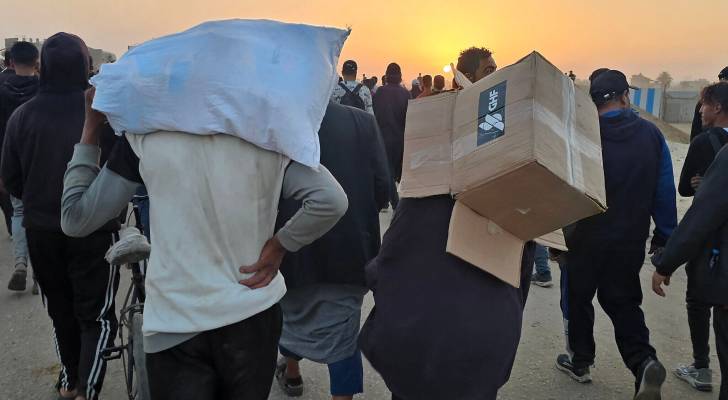Palestinians walk near a GHF distribution center in Rafah (Credit: AFP)
Leaked Gaza ‘deradicalization’ camp plan sparks fears of forced displacement: Reuters
A proposal obtained by Reuters has sparked concern among humanitarian experts over a plan to establish massive “Humanitarian Transit Areas” (HTAs) for Palestinians inside, and potentially outside, the Gaza Strip.
The plan, which carries the name of the US-aligned Gaza Humanitarian Foundation (GHF), outlines a USD 2 billion initiative to build large camps aimed to "temporarily residing" Palestinians, as well as "deradicalize, re-integrate and prepare to relocate if they wish to do so.”
According to two sources familiar with the matter, the proposal was shared with the Trump administration earlier this year and was recently discussed in Washington. The project’s stated aim is to transition control over Gaza’s population away from Hamas, presenting the HTAs as “voluntary” shelters where residents can temporarily live while Gaza is rebuilt.
The plan also appeared in a presentation obtained by Reuters, which includes maps, timelines, and cost estimates. One slide suggested the first camp could be functional within 90 days and accommodate over 2,000 people. A longer-term vision includes the construction of up to eight camps, each capable of housing hundreds of thousands. While the proposal did not explain how residents would be moved to these areas, it showed potential destinations including Egypt and Cyprus.
Despite the document prominently featuring the logos of GHF and the for-profit contractor SRS, both organizations have denied authorship or involvement. GHF told Reuters that the slides “are not a GHF document,” stressing that it is not planning or implementing any such camps. “Our focus is solely on food distribution,” the group said.
SRS echoed that message, saying it has had “no discussions with GHF about HTAs” and any claims suggesting otherwise were “entirely false.”
The White House declined to comment, while a senior US official said, “nothing of the like is under consideration,” and no funding is being directed toward it.
Still, the plan’s emergence has alarmed humanitarian leaders. “There is no such thing as voluntary displacement amongst a population that has been under constant bombardment for nearly two years and has been cut off from essential aid,” said Jeremy Konyndyk, head of Refugees International and a former US aid official.
Concerns over forced relocation resurfaced after former President Donald Trump suggested in February that the US should take over Gaza and turn it into the “Riviera of the Middle East” comments widely condemned by Palestinians and human rights groups.
Ismail Al-Thawabta, Director of Gaza's Government Media Office, told Reuters the foundation is “not a relief organization but rather an intelligence and security tool affiliated with the Israeli occupation.”
Since opening its food distribution operations in Gaza in May, GHF has coordinated with the Israeli Occupation Forces (IOF) and US security firms to move aid through non-UN channels, an approach favored by the Trump administration but criticized by the UN and aid groups. The United Nations has called the foundation’s operations unsafe and a breach of humanitarian neutrality, reporting that hundreds have died at GHF distribution sites or near convoys.
While the status of the camp proposal remains unclear, critics argue that even discussing such a plan in a war-ravaged and displaced population risk legitimizing mass relocation under the guise of humanitarian relief.




